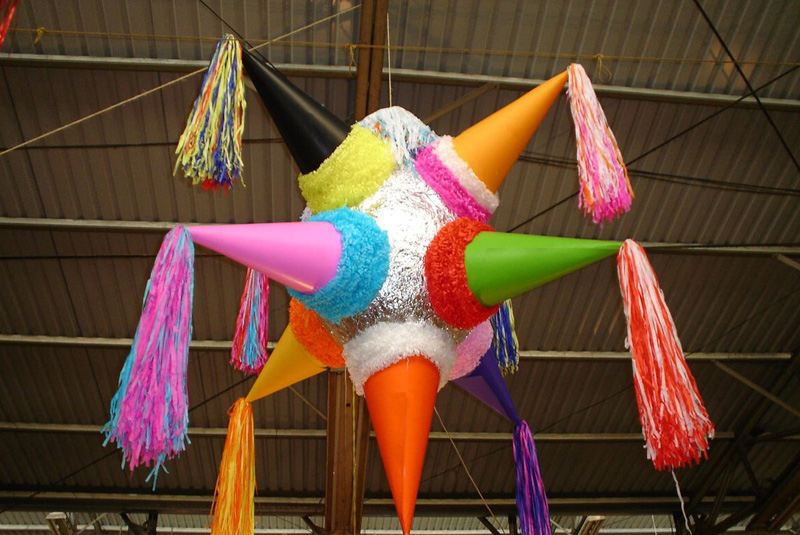
History of the Piñata
When you think of a traditional Mexican party, one of the first decorations that often comes to mind is a bright and colorful object made out of paper mache. Can you guess what it is? The piñata of course! While they are most often associated with children’s birthday parties, the piñata can be found in a variety of other celebrations and even just as a fun decoration. This ranges from office parties, Cinco De Mayo parties, Christmas celebrations, young and grown adult parties that want to add a fun aspect to the celebration, bachelor and bachelorette parties, and don’t forget you are almost sure to find one on display at a Mexican restaurant.
What makes piñatas so much fun? First, they always come in lively colors that make them stand out as a key decoration to any party. Even if your party does not necessarily have a Mexican theme, they still fit in well for any party you are looking to have. While piñatas are traditionally found in a star-like shape with points sticking out, you can pretty much find them in any shape or form, whether it’s an animal, your favorite cartoon character, numbers, letters, celebrities, or a sports ball. This allows them to truly fit in with any type of occasion.
If you are considering livening up your next party with some piñatas, you may be wondering “How did the piñata come to be?” It is well-known that the way piñatas traditionally work is once they are purchased or made, they are then filled with a variety of candy, money, gifts, and other sweets. Once filled with the treats, the piñata is then hung high up by a rope with two people holding each end of the rope on opposite sides. The child (or adult) is then blindfolded, spun around, and led towards the piñata. They will then attempt to hit the piñata as much as possible in order to break it open and release the goodies inside. Once someone breaks the piñata enough to let out most of the treats, the game is done and everyone collects as much of the candy as they can grab. However, the history of the piñata goes back way further than this commonly known tradition.
While this is how we currently think of the way piñatas work, they actually have a very unique history that started centuries ago. You may not have realized this, but piñatas are actually considered to have originated all the way over in China. The story goes that Marco Polo, while on one of his journeys in China, spotted some figures that resembled bulls, buffaloes, oxen, and other animals made out of a colorful type of paper. These figures were secured with harnesses and hit with sticks until seeds fell out. Afterwards, the paper was then burned in front of the crowd who would gather the ashes in hopes of experiencing good luck throughout the year.
It is then believed that after witnessing these rituals in the 14th century, Marco Polo introduced the idea to Italy. While the figures in China were thought to be created during the New Year celebrations, in Italy, they became linked with the period of Lent. The figures acquired the name “pignatta” which means “fragile pot.” This is because the piñatas from here were created without a base, and therefore looked similar to clay containers that were used to carry water. The first Sunday of Lent even became known as “piñata Sunday.”
From Italy, the idea of the piñata then made its way over to the country of Spain. It was still used in Lenten celebrations, including the first Sunday which was known here as “Dance of the piñata.” The clay pots were known as “La Olla” and people would dance around the pots in a celebratory fashion. As time progressed, people began adding a variety of decorations to these pots, such as such as ribbons, tinsel, and of course colorful paper. This is where the piñata began to start looking like the ones of today.
In the 16th century, Spanish missionaries brought the “La Olla” tradition over to “New Spain” in hopes that it would assist them in converting people. What they came to find, however, was that the people had their own tradition that was extremely similar in nature. It involved celebrating the birthday of the Aztec god of war, named Huitzilopochtli. Priests would lay out decorated clay pots on top of a pole in front of the god’s statue located at the temple. These pots were beautifully decorated with items such as feathers and other treasures. The pots would then be broken with a stick in order to release the treasures.
The Mayans would also play a game where they would try to hit a clay pot that was held up by a string. The catch is they would try to hit the pot while blindfolded. Eventually, all of these traditions became intertwined in order to create the piñatas and piñata traditions that we know today.
If you’re vacationing in Puerto Vallarta and are in town in order to celebrate a special occasion, then adding a piñata to your festivities is a great way to set a celebratory mood. The great thing about the piñata is there are so many options, so whether you want one that is small, big, or a perfect medium size, you will be able to find one that suites your celebration. If you really want to go all out you can even fill it up with candy and break it open in the traditional way. When planning your trip to Puerto Vallarta, choose a celebration-friendly Puerto Vallarta vacation rentals that everyone in your party will love. Best of all, you can always ask the front desk to point you in the direction of the nearest place to purchase a piñata!
